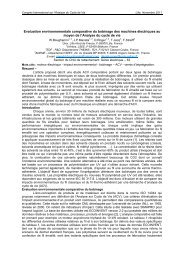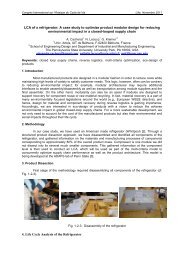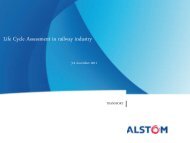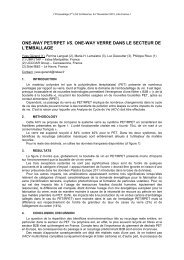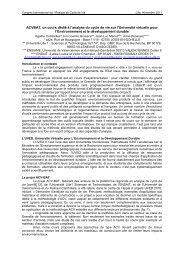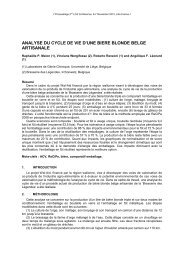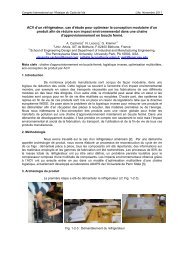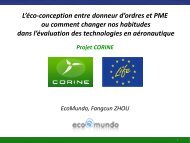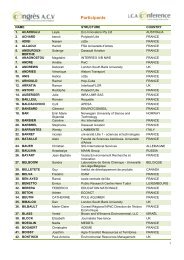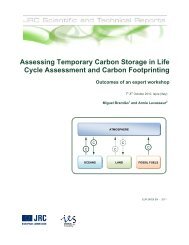Untitled - avniR
Untitled - avniR
Untitled - avniR
Create successful ePaper yourself
Turn your PDF publications into a flip-book with our unique Google optimized e-Paper software.
Congrès International sur l’Analyse du Cycle de Vie Lille, Novembre 2011<br />
Eco-design of a railway traction chain<br />
Ramzi Ben Ayed*, Stéphane Brisset*, Véronique Andriès**<br />
*Univ Lille Nord de France, F-59000 Lille, France<br />
*ECLille, L2EP, F-59650 Villeneuve d’Ascq, France<br />
**Alstom transport, rue Jacquard, 59494 Petite Forêt, France<br />
benayed.ramzi_ayed@ec-lille.fr, stephane.brisset@ec-lille.fr, veronique.andries@transport.alstom.com<br />
Section du CNU de rattachement : 63<br />
1. Introduction<br />
With the introduction of different environmental standards and regulations like ISO 14001 [1], ISO<br />
14040 [2] and the commission Regulation EC N° 640/2009 [3], industrial concerns are more and more<br />
oriented to the design of green products.<br />
2. Eco-design<br />
Ecodesign is an approach that allows the consideration and the minimization of an environmental<br />
criterion during the design steps. In literature the environmental criterion can be assessed by several tools.<br />
The Life Cycle Assessment (LCA) is among the most widely used.<br />
2.1 Life cycle assessment<br />
LCA is a preventive approach that takes into account the full life cycle of the product (from raw<br />
material extraction to end of life) and, the all environmental criteria (raw material depletion, water depletion,<br />
energy depletion, toxicity of water and air, hazardous waste production...). The LCA can be used in<br />
identifying the main environmental impacts and integrating them in earlier stage of the design process.<br />
2.2 Problems<br />
In a study that aims to improve the environmental performance of a railway traction chain, two<br />
challenges were taken up. The first one is to control costs while saving functional and technical<br />
performance of rolling stock. The second challenge is to achieve an eco-design of the railway traction<br />
chain. Based on the LCA, this work is difficult because many materials are used in the process of<br />
manufacturing and as consequence a lot of energy is consumed. To overcome these difficulties, effective<br />
solutions are proposed.<br />
2.3 Proposed solutions<br />
To reduce the amount of time required for the LCA of the railway traction chain, it is judicious to<br />
use environmental management software such as EIME® which helped us to build an environmental<br />
model. This model calculates 11 environmental indicators such as global warming, destruction of the<br />
ozone layer, water eutrophication, toxicity of air and water, etc. Then these impacts indicators are<br />
aggregated by the Impact 2002+ method [4] to achieve a single environmental indicator IE2002+. This<br />
indicator simplifies the comparison of environmental performance and also the minimization of<br />
environmental impacts using an optimization algorithm. This approach is shown in Figure 1.<br />
Optimizer<br />
Design<br />
parameters<br />
Multidisciplinary<br />
model<br />
lossess +<br />
material mass<br />
Environmental<br />
model (EIME)<br />
11 impacts<br />
indicators<br />
Aggregation<br />
method<br />
IE2002+<br />
Impact 2002+<br />
Figure 14 : ecodesign Temperature, process mass, efficiency of railway … traction components<br />
The minimization of impacts may leads to the deterioration of performance and / or the rise of<br />
costs. To solve this problem, optimization techniques are used. They are able to find a set of trade-offs<br />
between these conflicting criteria and ensure that obtained solutions have better performance (at least the<br />
- 73 -



